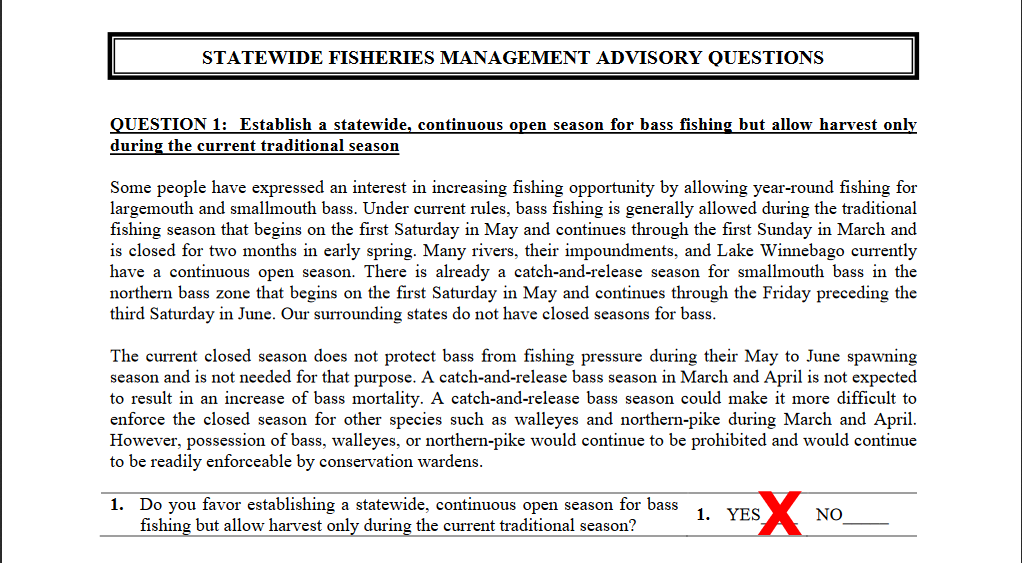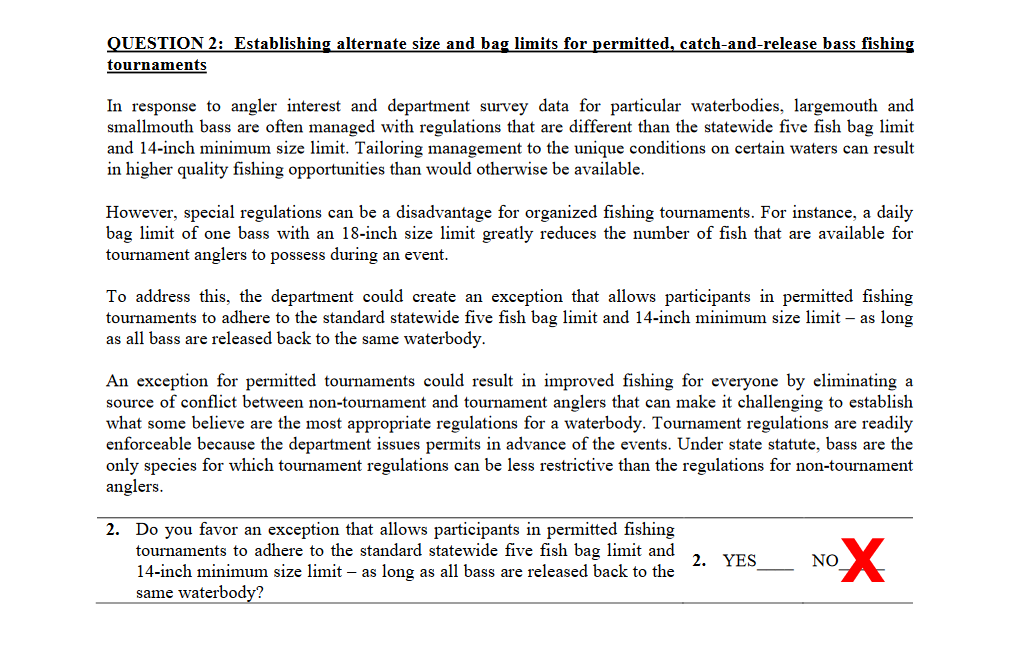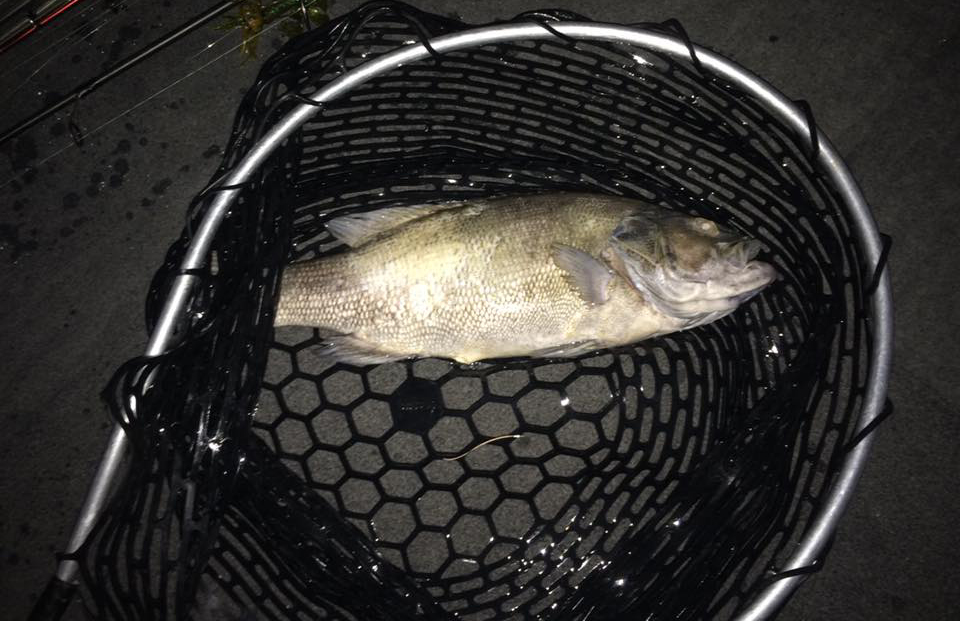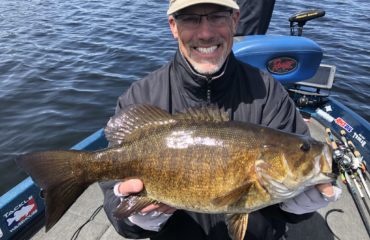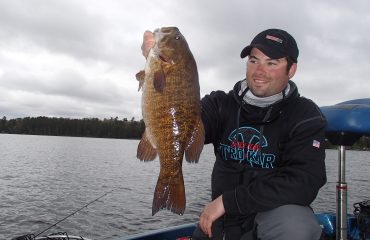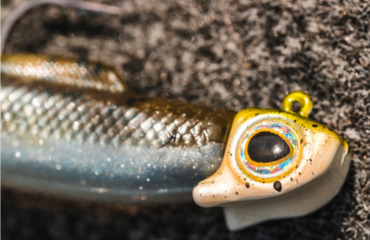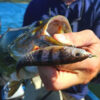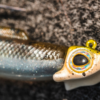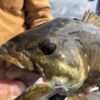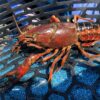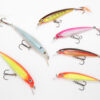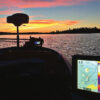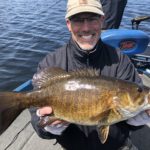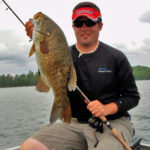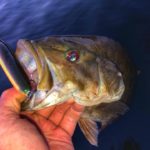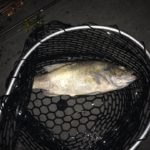Wisconsin Spring Conservation Congress 2018 – Help Save The Bass Fisheries!
On Monday, April 09, 2018, the Wisconsin Conservation Congress its hosting its annual spring hearings held in each Wisconsin county. This year a few proposals are hitting the advisory board concerning our state’s great bass fishing. These proposals could severely degrade fishing and a number of bass fisheries. Please attend your nearest location and cast your votes.
There will be 72 statewide public hearings, one in each county starting at 7:00 p.m. where individuals interested in natural resources management have an opportunity to provide their input by non-binding vote and testimony to the Department of Natural Resources, Natural Resources Board and the Conservation Congress on proposed rule changes and advisory questions relating to fish and wildlife management in Wisconsin. Individuals have the opportunity to bring forth new conservation issues of a statewide nature to the attention of the Conservation Congress through the citizen resolution process.
Wisconsin’s fishing and hunting regulations are some of the most comprehensive, and progressive, yet liberally managed in the country. Rules and regulations on a broad statewide scale are very generous with bag and harvest limits. While every lake and its bass fishery is different, the management plan continues to focus mostly to general and broad statewide regulations rather than shift to a more logical and effective regional, local, and lake-specific plan to accommodate special needs of waters to best effectively manage and maintain them.
Bass fishermen are known to be some of the most conscientious anglers, fisheries caring angling demographic. The proposals on this year’s ballot are in no way benefiting our demographic of anglers. Whether the intent is to keep or catch and release, most responsible fishermen in general know how to read and research regulations prior to fishing. Continuing to manage fisheries for the KEEP-KEEP-KEEP demographic of fishermen with broad statewide regulations that promotes harvest to depletion is truly an ineffective, antiquated way of managing an individual body of water for sustainability and success. When a fishery is depleted and degraded to no point of return, it’s always too late before the DNR and its rules makers act in time before it’s totally destroyed. That’s the modern philosophy. People suck, and so does the reality.
In 2018, Wisconsin is toying anglers with some new ideas that could negatively affect and impact a number of our individual water bodies and bass fisheries. My opinions, projected votes, and position is provided below.
Also, could Wisconsin DNR please propose its advisory questions in a more simplified manner? These gigantic sentences you will read are complex, confusing to process, and can screw up the common reader.
QUESTION #1 – VOTE YES
We vote YES to this one. The current closed gamefish rule caters to the southern half of Wisconsin more so than the north to prevent people from fishing open water – because they all have open ice free water while we don’t, and southern gamefish spawn much sooner there than in the northern half of the state.
I am absolutely in favor of establishing a statewide open season for bass fishing under the condition of closed harvest and no possession from the time gamefish harvest season closes (first Sunday of March) through mid June. I am against the harvest of any trophy fish and big bass for food, but as long as we have closed harvest seasons the fishery will be in good shape for years and generations to come.
Bass fisheries and resources are not treated as food sources. Neither are they speared and netted in spring. Bass also don’t spawn during March and April in Wisconsin either. Our lakes in the northern half of the state are also mostly ice covered at this time too, with ice-out usually not happening until mid April. The current rules for March and April, with total 100% closed fishing season for gamefish, is the most antiquated rule in the book. It’s bad for the tourism industry and economics. Bass fishing generates millions of dollars to Wisconsin economies and the fishing/outdoors industry. The current program is not scientifically supported either.
People who are ignorant and don’t care will harvest fish during closed seasons anyways. Nothing will stop them from their destructiveness. It’s the criminal mind. Open the season to catch and release fishing, and employ more game wardens and officials to enforce regulations and laws.
An open fishing season that is mandated for 100% catch and release and ZERO POSSESSION will keep bass anglers happy statewide, and create and open new early season fishing opportunities to the southern half of Wisconsin. Keeping it to a strict catch and release policy like May thru Mid June will also allow our prized quarry to reproduce when it’s time for them to do so later in spring. Wisconsin must follow Michigan’s bass fishing model for early spring in order for this plan to truly work.
As a follow up to this question, Wisconsin must consider the closure of smallmouth bass harvest from October through winter, which I feel is more sensitive than this subject. More trophy smallmouth are harvested, and bass populations are destroyed during this time of high-concentration and heavy fish schooling than any other point during the year.
QUESTION #2 – VOTE NO
How about rephrasing the question – as long as bass are immediately released back to the same waterbody? …… and not 8 hours later, barely swimming.
We vote NO to this one. It will not improve fishing for everyone. It will stress and pressure the already fragile fisheries with low bass populations. Low density bass waters with the 18-1 rule are established for the best interests of a lake and its low bass population. Not for tournaments.
I enjoy tournaments, especially those that are cutting-edge and operate with CATCH-RECORD-RELEASE. This assures quality care and guaranteed survival.
As the current system is played, no trophy fish should ever sit in a livewell for a full day, get stressed out, and be paraded around for pictures and a weigh-in before it gets released and displaced from where it was homing at. This is why I do not like tournaments, especially when I see floating 18-inchers following events on my favorite lakes. Do this to a lake with an 18-1 limit and its fragile fishery, and that lake is bound to be stressed till depletion. A lot of the bass in these low density 18-1 lakes are old, ancient fish. Kill them, and you kill that fishery.
The proposal won’t benefit tournaments and lakes with 18-1 rules. These special management bass lakes have low density fish populations, and are created and managed as such to maintain and conserve their low populations of fish. Many of them may only have a couple hundred bass swimming in them altogether, making the proposal nonviable and unrealistic to succeed. Consequently, these lakes have very low catch rates, and I’ll be surprised if any tournament field of 10+ boats ever catches their limit of 5 fish in any event.
Another host of problems this proposition brings is Wisconsin poorly regulates tournaments. Permits were once required for events with 10 or more boats. That rule was recently adjusted, with permits now only needed for fields larger than 20 boats. Most bass clubs only field events of 10 boats, or set a cap of less than 20 boats in order to avoid permit authorization. Certain tournament groups have sloppy fish possession and weigh-in procedures.
By opening up tournaments to low-density bass waters, and giving an exemption to the 18-1 rule, caters to a small demographic of anglers rather than to the best interests of a lake and its fragile, limited resource.
Come to Minocqua in July, the hottest month of the year, where every weekend a bass club our tournament is held on some of the more popular lakes and chains. Delayed mortality is a guarantee. To cut some corners these groups limit the fields to 19 boats or less to avoid permits and still do payouts, weigh-ins, and all day catch and transport. Culling, who knows. Almost every July, I’ll find a few floaters up to 20″ right next to the boat landings which serves as a release site for events.
I am not against tournaments, but many waters, including these low density 18-1 lakes are incapable of handling the pressure. I have fished a few buddy derbies and the ABA before, and have some good friends who tournament fish also. I do not fish them now because the culture doesn’t align with my conservation and fishing philosophies. I do not fish them because I cannot put ego ahead of fishery, nor is it wise to possess 5 fish for 10 hour days only to release them after a picture. I see and experience the aftershocks and after effects of these events by sometimes finding dead fish floating up like this.
Come on Wisconsin. Stop putting a demographic’s ego and weights ahead of the resource. Why isn’t anybody attempting doing record and release? Is a fish pic from a boat and live releasing not glamorous and fame enough? I do those photos and take a quick weight every day, and the 20 inchers are there to be caught again and again for myself and others. I see far too many floaters like this one following some of these events despite reading reports, “All fish were released alive back into the lake.”
Is this how potentially 15-20 year old fish are to be treated?
A major allure to Wisconsin’s inland bass fishing is the number of trophy-regulated 18-1 and catch and release only lakes available. This limits fishing pressure and eliminates harvest by law abiding fishermen. It promotes conservation and results in gigantic fish to be caught and released. Bass tournaments belong on big water and lake chains. Not low density 500 acre inland ponds with 18-1 conservation rules in place.
QUESTION #28 – VOTE YES – or – NO
I am amazed that largemouth bass continue to be managed together with smallmouth bass – two completely different fish with personalities. Wisconsin anglers are not cro-magnons, and there is no further need to manage both species together.
I go both ways with this question. My vote is YES in order to avoid the man-made creation and disaster of bass fisheries like the Minocqua Chain. An overabundance of 10-14 inch bass is destruction to the lake, its biomass, and to all fish species. A lot more bass lakes like this one are scattered throughout the state.
Additionally, I would vote NO also, to support my tournament brothers. This proposition wreaks havoc to tournaments and their current 14-5 system, UNLESS THEY RECEIVE EXEMPTIONS TO THE RULE, which could be possible and makes most sense. I also vote NO, because not all largemouth fisheries are equally the same. Certain lakes have bigger fish than others, while others have more or less fish in them than others too. Voting YES would even the playing field for all largemouth lakes. This would be a problem, and I feel a lot of quality trophy largemouth lakes could suffer from the promotion of harvest. Voting YES also promotes harvest of a good substitute table fare.
The north has an overabundance of largemouth, and on many lakes this has become a problem that has presented several non-ideal solutions. The current solution is to mass-exodus all largemouth bass, as some lakes have a year-round free-for-all with a bag limit of 5. This has unfortunately promoted the unnecessary harvest of trophy fish. Not all largemouth bass are meant for harvest and eradication however. For experimental purposes, establishing slot limits with a protected 15-20″ slot will keep adult bass in the system, maintain the quality and integrity of the fishery, while promoting harvest of the desirable food fish sizes. Slots and a harvest targeting specific sizes would work wonders, and have been miracles to many lakes and fish species throughout Minnesota and Ontario.
This 12-to-3 harvest adjustment could work exceptionally well to curb the largemouth bass explosion of lakes. It could also promote small bass as favorable table fare – and when prepared properly and bled quickly, smaller largemouth bass are some of the tastiest fillets one could have.
12 inch bass are more favorable for harvest than 14 inch and larger bass, which are already sexually mature and the fishery’s up-and-comers. Would you rather harvest 5 big fish at 14 inches or larger, which taste really gross? Or would you want to take 3 younger and fresher ones, with the likelihood they will all mostly be 12-14 inches in average size and taste really good?
Vote yes or no to this one. Doesn’t matter to me, because I don’t fish tournaments.
Lets make ourselves and presence be known on April 9th!




